The planets can be divided into two groups: the Earth group and the gas planets and rock-ice dwarf planets group. The Earth group consists of planets with high density and are mainly composed of silicates and metallic iron. In contrast, the gas planets and rock-ice dwarf planets group includes planets found in the Kuiper belt and the Oort cloud.
The largest planet in the Earth group is Earth, which is more than 14 times less massive than the smallest gas planet, Uranus. However, Earth is about 400 times more massive than the largest known Kuiper Belt object.
Planets in the Earth group are primarily composed of oxygen, silicon, iron, magnesium, aluminum, and other heavy elements.
All planets in the Earth group have a similar structure, consisting of a core made of iron with some nickel, and a mantle made of silicates.
Out of the terrestrial planets, two of them (Earth and Mars) have natural satellites, while none of them, unlike the giant planets, have rings.
Exoplanets Similar to Earth
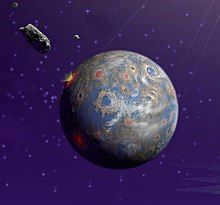
Also check out: Super-Earth and Mini-EarthEarth-type planet during its formation (illustration)
Earth-like planets are considered to be the most conducive to the development of life, making them a topic of great public interest. For instance, in December 2005, researchers from the Space Science Institute in Pasadena, California, announced the discovery of a star similar to our Sun that is believed to be surrounded by rocky planets in the process of formation. Subsequent findings revealed the existence of planets that are only a few times larger than Earth and likely possess a solid surface.
Super-Earths are examples of Earth-like exoplanets, with over 50 such discoveries made as of June 2012.
The Gaia space telescope has provided new data on the distances and luminosities of 130 million stars. Based on this data, the Kepler telescope has identified 30 exoplanets that are similar to Earth and potentially habitable. According to optimistic estimates, 12 of these planets are still considered to be Earth-like worlds within the habitable zone in 2018, while the most pessimistic estimates suggest that only 2 of these planets retain this status.
| This is a sample astronomy article. You can contribute to the project to make it better. |
Earth
- Anglo-Australian Planet Search
- Automated Planet Finder
- California and Carnegie Planet Search.
- HATNet Project
- HARPS, part of Geneva Extrasolar Planet Search
- HATSouth
- Project MEarth
- MOA
- OGLE
- Magellan Planet Search Program
- SuperWASP
- TrES
- XO Telescope
- EAPSNet
- High Resolution Echelle Spectrometer (HIRES)
- MARVELS
- MUSCA
- MicroFUN
- NASA-UC Eta-Earth
- PHASES
- PlanetPol
- PARAS
- Subaru Telescope, using HiCIAO instrument
- Systemic, an amateur project to search for exoplanets.
- ZIMPOL/CHEOPS.
- GPI
- MOST (2003 – present)
- EPOXI (2005 – 2013)
- SWEEPS (2006)
- COROT (2006 – 2013)
- “Kepler” (2009 – 2018) (KOI, list)
- Gaia (2013 – present)
- TESS (2018 – present)
- “Cheops” (2019)
- EXCEDE (2019)
- New Worlds Mission (2020)
- EChO (2022)
- PLATO (2026)
- ATLAST
- LUVOIR
- PEGASE (pending)
- TPF (delayed)
- “Darwin” (delayed)
- Eddington (cancelled)
- SIM (cancelled)
Are you aware of the two classifications into which all planets in the solar system can be divided? While each planet has its own unique conditions determined by factors such as its distance from the Sun, the shape of its orbit, and its formation processes, they can still be categorized based on their similar structure and composition. There are two types of planets in the solar system: solid planets and gas planets. The solid planets, also known as earth-like planets due to their similarity in physical and chemical parameters, are closer to the central star. On the other hand, the gas planets are farther from the Sun, possess a similar atmosphere, and lack a solid surface.
In this article, we will thoroughly examine these two groups of planets in the solar system and explore their similarities and differences.
The planets of the terrestrial group include Mercury, Venus, Earth, and Mars. These planets are also known as the inner planets of the solar system due to their proximity to the Sun.
All of these planets have an iron-nickel core, a mantle made up of molten silicates, and a rocky surface rich in iron. However, Mercury is the only planet that lacks a crust, which has been stripped away due to numerous meteorite collisions.
Among the four inner planets, only Earth and Mars have satellites. Earth has the Moon, while Mars has Phobos and Deimos. None of these planets have rings.
Despite their similarities, the terrestrial planets have notable differences. The table below provides a comparative overview of the key parameters of the first four planets in the solar system, along with accompanying photographs.
- Mercury weighs 3.3*1023 kilograms and has a size of 4.9*103 kilometers. It possesses an extremely thin atmosphere comprised of hydrogen and noble gases. The temperature ranges from a minimum of -183° Celsius to a maximum of 75° Celsius.
- Venus has a mass of 4.9*1024 kilograms and a diameter of 12*103 kilometers. It is enveloped in a dense atmosphere of carbon dioxide, with numerous sulfur clouds. The temperature undergoes minor fluctuations throughout the day. The average temperature is 470° Celsius.
- Earth has a mass of 5.98*1024 kilograms and a diameter of 12.74*103 kilometers. It boasts a dense nitrogen-oxygen atmosphere that is suitable for sustaining life. Temperature fluctuations on a cosmic scale are negligible. The average temperature is 14.8° Celsius. The presence of climate belts can be observed.
- Mars has a mass of 6.42*10^23 kg and a diameter of 6.8*10^3 km. It has a sparse atmosphere containing traces of methane, hydrogen, and noble gases. The surface temperature ranges from -82° to -30° C.
Table of the inner four
Giant planets
This category includes the gas giants of our solar system: Jupiter, Saturn, Uranus, and Neptune. They are known as the outer planets due to their distance from the Sun. The main characteristic of gas giants is their dense atmosphere consisting mainly of hydrogen and helium, which transitions into a liquid mantle layer. In the case of Jupiter and Saturn, this mantle is made up of metallic hydrogen, while in Uranus and Neptune, it is composed of ammonia, water, and methane. Beneath the mantle, these planets have a hot metallic core.
All four gas giants in our solar system have ring systems and multiple moons. Saturn has the most prominent rings, while Jupiter has the largest moons. The atmospheres of these planets experience rapid movement due to internal heating, resulting in massive hurricanes.
Uranus and Neptune belong to a separate category known as ice giants. The lower layers of their atmospheres reach the coldest temperatures recorded in our solar system, dropping to as low as -220°C.
A table featuring the key characteristics of these outer four planets, along with accompanying photos, is provided below.
- Jupiter: Mass: 1.9*10^27 kg, Diameter: 140*10^3 km, Known Satellites: 79, Distance from Sun: 779*10^6 km.
- Saturn: Mass: 5.7*10^26 kg, Diameter: 117*10^3 km, Known Satellites: 62, Distance from Sun: 779*10^6 km.
- The mass of Neptune is 1.02*1026 kg with a diameter of 49.3*103 kg. It is known to have 14 satellites and is located 4.6*109 from the luminary.
How are the planets of the solar system categorized?
To me, the vast expanse of space is an endless, uncharted, and beautiful realm. Every day, we gaze upon the stars, the Moon, and of course, the Sun in the sky. However, there are other planets that we cannot see. Why is that? It’s quite simple – they are incredibly distant from us and often appear indistinguishable from the stars. So, what exactly are the planets in our solar system, and how are they classified?
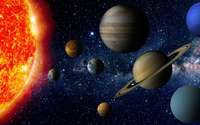
This is the initial category out of two, which comprises of four celestial bodies (planets) situated within the solar system:
It is postulated that other systems also exhibit a division into two categories: inner and outer. In addition to the planets, certain asteroids can be classified within the Earth category due to their similar composition. The Earth, being the largest in this category, consists of oxygen, iron particles, as well as aluminum and magnesium. Interestingly, the structure of these planets mirrors that of the Earth, encompassing a core, followed by a mantle and an upper layer known as the crust. Moreover, there are discrepancies among these planets, specifically, only Mars and Earth possess natural satellites.

Following the first group, there is another group consisting of four planets:
These massive celestial bodies are located beyond the asteroid belt. Similar to the planets in the Earth group, they share similarities in terms of composition and their properties. This particular group is referred to as the outer group as well.
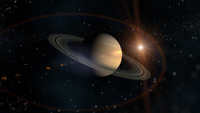
All gas planets belong to the second group and they are significantly larger and more massive compared to those in the first group. When it comes to their main characteristics, these planets have a rapid rotation, thick atmospheres, and some of them even have rings. Saturn is known to have the largest rings, while other gas planets’ rings are barely visible. Another interesting fact is that these celestial bodies have a high number of natural satellites. Moreover, there is a hypothesis suggesting the existence of a ninth planet that is located at the farthest distance from the Sun.
Popular topics:
Republic of Mountain Altai Map of Russia → Republic of AltaiDetailed map of Republic of Altai Altai on Russian map. Detailed map of Republic of…
Differences between giant planets and earth group planets What is a planet called? “Planet” means “wandering” in Greek. This name originated from…
Souvenirs of Orenburg Shawl and down How to avoid bringing back the down shawl from Orenburg? Especially because…
Types of conventional signs § 6. Types of conventional signs Question 1. What are the different types of images of the earth’s surface? There are…
Identify the listed Water resources. Types of water resources and availability. Water resources encompass all types of…
Get the Files:
| lesson_plan_word.doc | 55.5 KB |
| powerpoint_attachment.ppt | 2.99 MB |
Preview the Lesson:
Teacher specializing in natural history and geography
"Enhancing learning through the use of technology and Microsoft products" when teaching natural and mathematical subjects.
5th grade natural history class
This lesson plan for natural history focuses on the topic "Solar System: Earth’s Group of Planets" from the "Universe" unit covered in the first half of the 5th grade. It introduces students to the solar system, its structure, and the planets in Earth’s group.
The lesson development can be beneficial for natural history teachers.
Reinforcement of new material
This lesson development is created using the Microsoft Power Point program, which enables teachers to conduct lessons with a wide range of illustrative material. This is particularly helpful for middle school students, as they often have a visual and imaginative thinking style. In a traditional lesson, teachers would have to switch between different sets of illustrations, which can be time-consuming. By using the Microsoft Power Point program, teachers can save time during lessons and dedicate it to developing students’ intellectual abilities. Lessons with presentations are visually appealing, expressive, emotional, effective, and successful.
Lesson Topic: “The Solar System. Planets in the Earth Group”.
1. Students need to familiarize themselves with the structure of the solar system; the planets in the Earth group and their characteristics.
- Develop logical thinking skills; analyze, compare, draw conclusions; work with the textbook text, extract relevant information from it.
II. Homework Review. Recap of what we have learned.
– How did Copernicus’ heliocentric model differ from Ptolemy’s geocentric model?
– What contribution did G. Bruno make to our understanding of the Universe?
– What is the current scientific model of the Universe?
III. Introduction to new material.
– What is the definition of the solar system?
The Solar System consists of the Sun and the various celestial bodies that orbit around it. It is believed that the Solar System formed approximately 4.5 to 5 billion years ago from a cloud of gas and dust.
There are a total of 8 planets in the Solar System, many of which have their own moons. These planets can be divided into two groups: terrestrial planets and giant planets.
The terrestrial planets include Mercury, Venus, Earth, and Mars. Mercury, the planet closest to the Sun, is named after one of the ancient Roman gods. It is much smaller than Earth and has a similar size and mass to the moon. Its surface is covered in numerous craters and mountains, resembling the moon. Due to its proximity to the Sun, the surface of Mercury can reach temperatures of up to +400°C. Unlike Earth, Mercury has a very thin or almost nonexistent atmosphere.
Venus got its name from the Roman goddess of love and beauty, which is not a coincidence. In the sky, it shines brighter than any star and can easily be seen with the naked eye. The majority of Venus’ surface is covered with hilly plains, and there are also mountainous regions on the planet. One of these areas is home to a massive volcano that reaches a staggering height of 12 kilometers.
Earth is the largest among the terrestrial planets and has an atmosphere comprised of nitrogen, oxygen, and a small amount of carbon dioxide. However, the most notable distinction between Earth and the other planets is the presence of life solely on our planet. Earth is also accompanied by one satellite, the Moon.
Mars, the red planet, which bears a resemblance to the color of fire and blood, was given its name in honor of the ancient Roman god of war. The planet’s surface is covered in deserts, craters, and mountains, some of which are incredibly tall. For instance, the dormant volcano Olympus reaches a staggering height of 27 kilometers. The soil on Mars is abundant in iron, which accounts for its reddish hue. In addition, Mars has two moons, Deimos and Phobos.
– Utilize your textbook to complete the table
Existence of atmosphere, its composition
Existence of moons, their quantity
Mercury – lacks an atmosphere.
Venus – possesses a dense, cloudy atmosphere composed mainly of carbon dioxide.
Earth – teeming with living organisms.
Mars – features polar caps that are white and consist of a frozen mixture of water and carbon dioxide.
– Counting the “planets of the solar system”.
V. Recapitulating the lesson.
- Write down your solution for task 1 in the “Think” section.
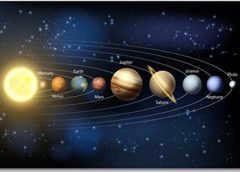
Throughout history, humanity has been fascinated by the planets of the Solar System due to their close proximity and visibility from Earth. Here is a concise summary of the eight planets in our solar system, arranged in order from the nearest to the Sun to the farthest.
The order of the planets in the solar system starting from the Sun:
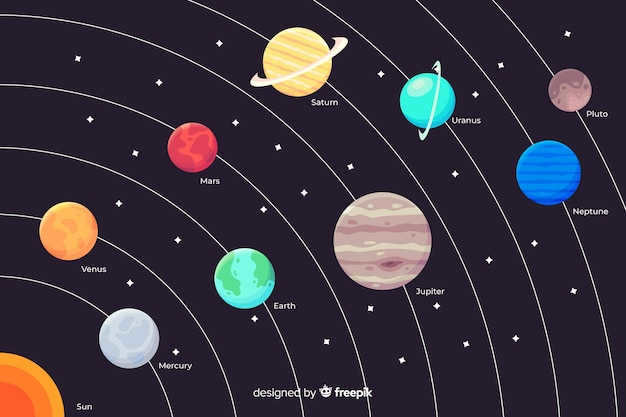
- Mercury is the first planet from the Sun.
- Venus is the second planet from the Sun.
- Earth is the third planet from the Sun.
- Mars is the fourth planet from the Sun.
- Jupiter is the fifth planet from the Sun.
- Saturn is the sixth planet from the Sun.
- Uranus is the seventh planet from the Sun.
- Neptune is the eighth planet from the Sun.
- Is there a ninth planet?
What is the total count of planets in the solar system?
Ever since the identification of Pluto in 1930, the solar system has been believed to consist of nine planets. However, this belief was challenged in the late 90s when astronomers initiated a debate regarding the status of Pluto as a planet.
Following a highly controversial decision, the International Astronomical Union ultimately classified Pluto as a “dwarf planet” in 2006, thereby reducing the number of recognized planets in the solar system to eight.
Nevertheless, astronomers continue their search for a potential ninth planet in our solar system, as evidence supporting its existence was mathematically discovered on January 20, 2016.
Solar system planets: characteristics
The four inner planets that are closest to the Sun – Mercury, Venus, Earth, and Mars – are commonly referred to as “terrestrial planets” due to their rocky surfaces. Pluto also possesses a rocky surface, although it is frozen, and is not typically grouped with the other four terrestrial planets.
The four large outer planets – Jupiter, Saturn, Uranus, and Neptune – are occasionally referred to as “Jupiter-like” because of their immense size in comparison to Earth.
They are primarily composed of gases such as hydrogen, helium, and ammonia rather than having rocky surfaces, although astronomers speculate that some or all of them may have solid cores.
Jupiter and Saturn are often referred to as gas giants, while the more distant Uranus and Neptune have been labeled as ice giants.
Here is a concise summary of the eight genuine planets in our solar system, listed in order from the nearest to the Sun to the farthest:
Mercury
Mercury, which takes only 88 days to complete a full orbit around the Sun, holds the distinction of being the planet closest to our star. It is also the smallest planet, just slightly larger than a month on Earth.
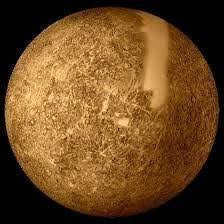
Mercury undergoes significant variations in temperature between day and night. During daylight hours, the surface can reach scorching temperatures of 450°C, which is hot enough to melt lead. Conversely, on the nighttime side, temperatures plummet to a bone-chilling minus 180°C.
- Discovery: Known to the ancient Greeks and visible to the naked eye
- Named after the messenger of the Roman gods.
- Diameter: 3078 miles (4878 kilometers)
- Orbit: 88 Earth days
- Day: 58.6 Earth days
Venus
Venus, the second planet in our solar system, is of the same magnitude as Earth. Radar scans conducted beneath its atmospheric layer have revealed the presence of mountains and volcanoes on its terrain.
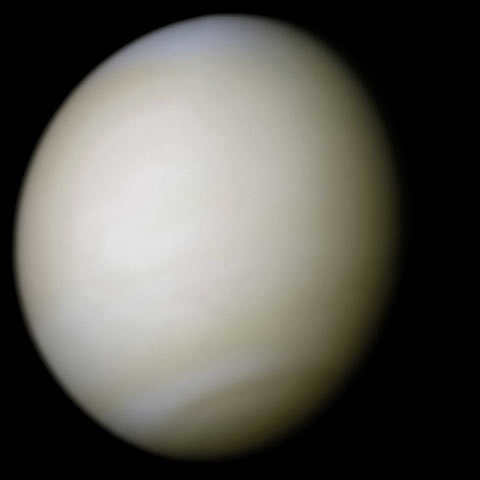
Due to its dense and noxious atmosphere composed of sulfuric acid clouds, Venus serves as an extreme illustration of the greenhouse effect. It surpasses even Mercury in terms of heat, with surface temperatures averaging at 900 F (465 C).
Venus exhibits a slow rotation, moving from east to west, in a direction opposite to that of most other planets.
- Discovery: Familiar to the ancient Greeks and observable without the aid of telescopes
- Named after the Roman goddess associated with love and beauty
- Diameter: 12,104 kilometers
- Orbit: 225 Earth days
- Day: 241 Earth days
Planet Earth
Planet Earth, the third celestial body from the Sun, is a unique watery sphere, with approximately two-thirds of its surface being covered by vast oceans. This remarkable planet is the sole known habitat where life flourishes.
Moreover, Earth boasts a distinctive atmosphere, abundant in nitrogen and oxygen, which contributes to its thriving biosphere.
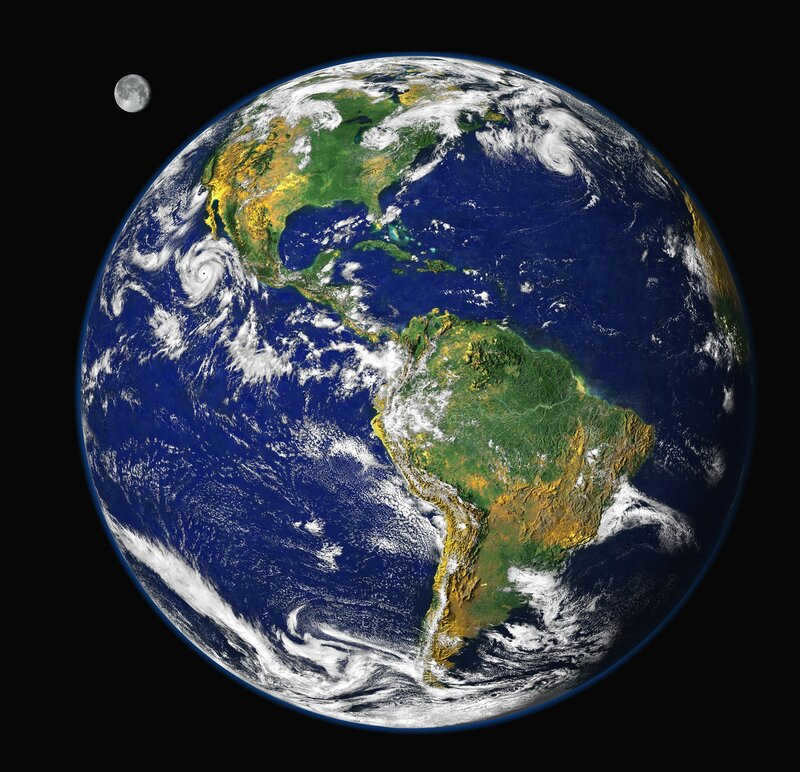
The Earth spins around its axis at a speed of 1,532 feet per second (467 meters per second), which is slightly over 1,000 miles per hour (1,600 km/h) at the equator.
- The name “The Earth” in English comes from the German word “Die Erde”, meaning “earth”.
- Diameter: 12,760 kilometers
- Orbit: 365.24 days
- Day: 23 hours and 56 minutes
Mars
The planet Mars, located as the fourth planet from the Sun, is characterized by its cold and arid terrain, which is predominantly covered in a layer of dust. This dust is primarily composed of iron oxides, lending the planet its distinctive red coloration.
Similar to Earth in many ways, Mars boasts a rocky landscape adorned with mountains, valleys, and canyons. Additionally, the planet experiences various atmospheric phenomena such as storms and dust storms.
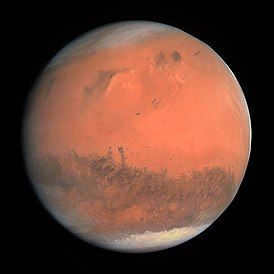
According to scientific evidence, Mars was once a significantly warmer and wetter planet billions of years ago.
It is also believed by scientists that ancient Mars possessed the necessary conditions to sustain life, including bacteria and other microorganisms.
- Discovery: The ancient Greeks were aware of its existence, and it was visible to the naked eye.
- Named after the Roman god of war
- Diameter: 6717 kilometers.
- Orbit: Takes 687 Earth days
- Day: Slightly longer than one Earth day (24 hours, 37 minutes).
Planet Jupiter
Jupiter, the fifth planet from the Sun, is an enormous gas giant that holds the distinction of being the largest planet in our solar system. In fact, it is over twice as massive as all of the other planets combined.
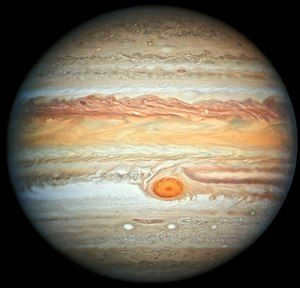
The various types of gases give Jupiter’s swirling clouds their vibrant colors. The most notable feature among these clouds is the Great Red Spot, a massive storm spanning over 10,000 miles in width. This tempest has been raging at speeds exceeding 400 mph for the past 150 years. Jupiter boasts a powerful magnetic field and, with its 75 moons, it resembles a scaled-down version of a solar system.
- Discovery: The ancient Greeks were aware of its existence, and it could be observed with the naked eye.
- Named after the ruler of the Roman gods.
- Diameter: 138,822 km
- Orbit: 11.9 Earth years
- Day: 9.8 Earth hours
Saturn, the sixth planet from the Sun, is most famous for its magnificent rings.
These rings consist of a combination of ice and rocks, and the exact process of their formation remains a mystery to scientists. Unlike Saturn, Jupiter is a gas giant primarily composed of hydrogen and helium.
- Discovery: Saturn has been known to the ancient Greeks and has been visible to the naked eye.
- Naming: The planet was named after the Roman god of agriculture.
- Diameter: Saturn has a diameter of approximately 120,900 kilometers.
- Orbit: The planet completes one orbit around the Sun every 29.5 Earth years.
- Day: A day on Saturn lasts about 10.5 Earth hours.
Uranus
Uranus, the celestial body positioned as the seventh one from the Sun, possesses a rather peculiar characteristic. Specifically, it encompasses vast formations of hydrogen sulfide, a chemical compound that is responsible for the distinct odor associated with rotten eggs.
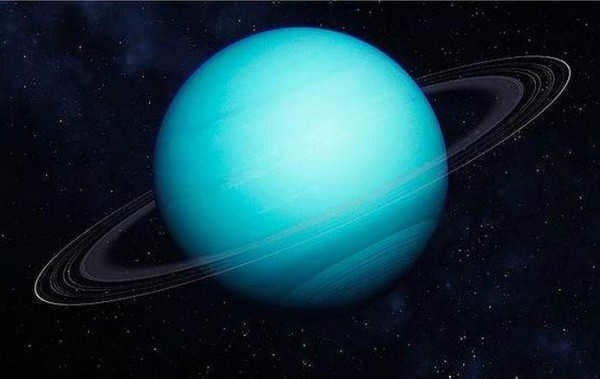
Unlike Venus or any other planet, Uranus rotates on its side with its equator at almost a right angle to its orbit. Astronomers believe that about 4 billion years ago, Uranus was struck by an object twice the size of Earth, causing its tilt.
Uranus was discovered in 1781 by William Herschel, who initially thought it was a star. It is named after the personification of the sky in ancient mythology. With a diameter of 51,120 kilometers, Uranus has an orbit that lasts 84 Earth years and a day that lasts 18 Earth hours.
Neptune
Neptune, the eighth planet in our solar system, is approximately the same size as Uranus and is renowned for its powerful gusts of wind.
Neptune is located at a considerable distance from the Sun and has a frigid climate.
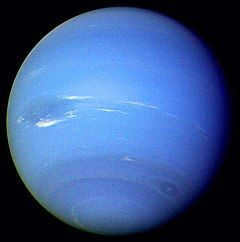
Neptune was the first planet to be mathematically calculated before it was visually observed.
Neptune has a rocky core and is approximately 17 times more massive than Earth.
- Discovered in 1846
- Named after the Roman god of water
- Diameter: 49530 kilometers
- Orbit: 165 Earth years
- Day: 19 Earth hours
Formerly known as the ninth celestial body revolving around the Sun, Pluto stands out from the rest of the planets due to its distinctive characteristics. Notably, it has a smaller size compared to Earth’s natural satellite, the moon, and its orbital path is significantly more elongated in shape.
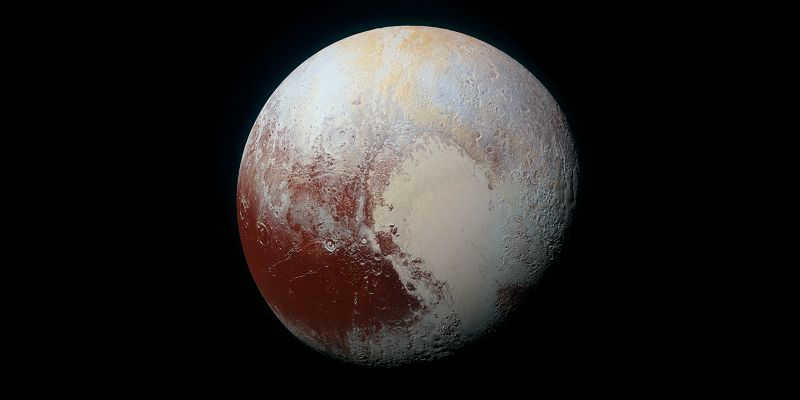
Pluto is an icy world that is characterized by its cold temperatures and rocky terrain. It has a weak atmosphere and is known for its active nature, with glaciers, mountains of icy water, and ice dunes covering its surface. Scientists believe that there may even be cryovolcanoes on Pluto, which erupt with icy lava made of water, methane, or ammonia.
- Pluto was discovered in 1930 by Clyde Tombaugh.
- It was named after the Roman god of the underworld, Hades.
- Pluto has a diameter of 1,430 miles (2,301 kilometers).
- Its orbit around the sun takes 248 Earth years.
- A day on Pluto lasts 6.4 Earth days.
The discovery of the ninth planet
However, the solar system is not limited to just the eight known planets. In 2016, scientists put forward a hypothesis suggesting the presence of a ninth planet, which has since been dubbed “Planet Nine” or Planet X.
This mysterious planet is believed to have a mass approximately 10 times that of Earth and follows an orbit around the Sun that is 300-1000 times more distant than the Earth’s orbit.
Similar news
What is lightning and explore fascinating information about lightning and uncover captivating details about lightning

What is the functioning mechanism of a nuclear power plant?
Gather knowledge about the operation of a nuclear power plant, explore the various types of nuclear reactors in existence, and grasp the fundamental principles underlying nuclear power.
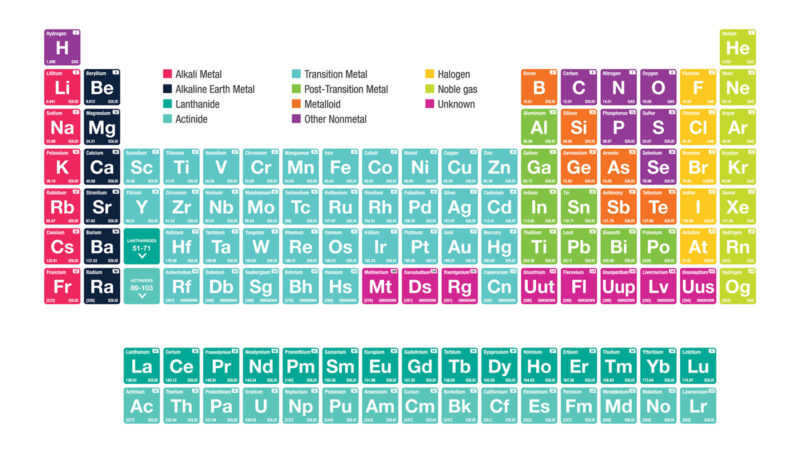
What is the total number of elements in Mendeleev’s table?
Have you ever pondered the quantity of elements present in Mendeleev’s table? We are embarking on a quest to unveil an astonishing multitude of elements.
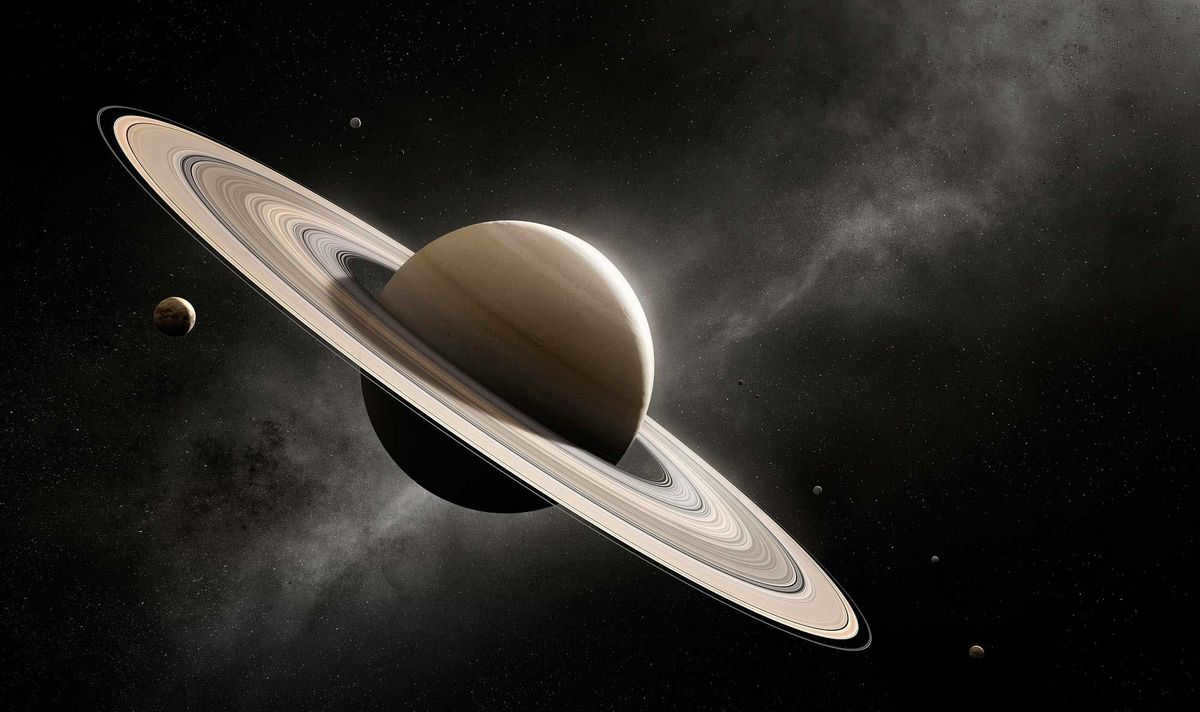
Jupiter, Saturn, Uranus, and Neptune all share a common feature within the solar system. Aside from having satellites, they possess rings! Each of these four planets is surrounded by a distinctive set of flat rings comprised of dust and ice.
If you want to observe Saturn’s rings, all you need is a pair of binoculars. However, to view the rings on Jupiter, Uranus, and Neptune, a large ground-based telescope or even a spacecraft is necessary. The rings surrounding the latter three planets are too faint, requiring the use of powerful optics.
Allow me to introduce you to these extraordinary constructions.
Jupiter
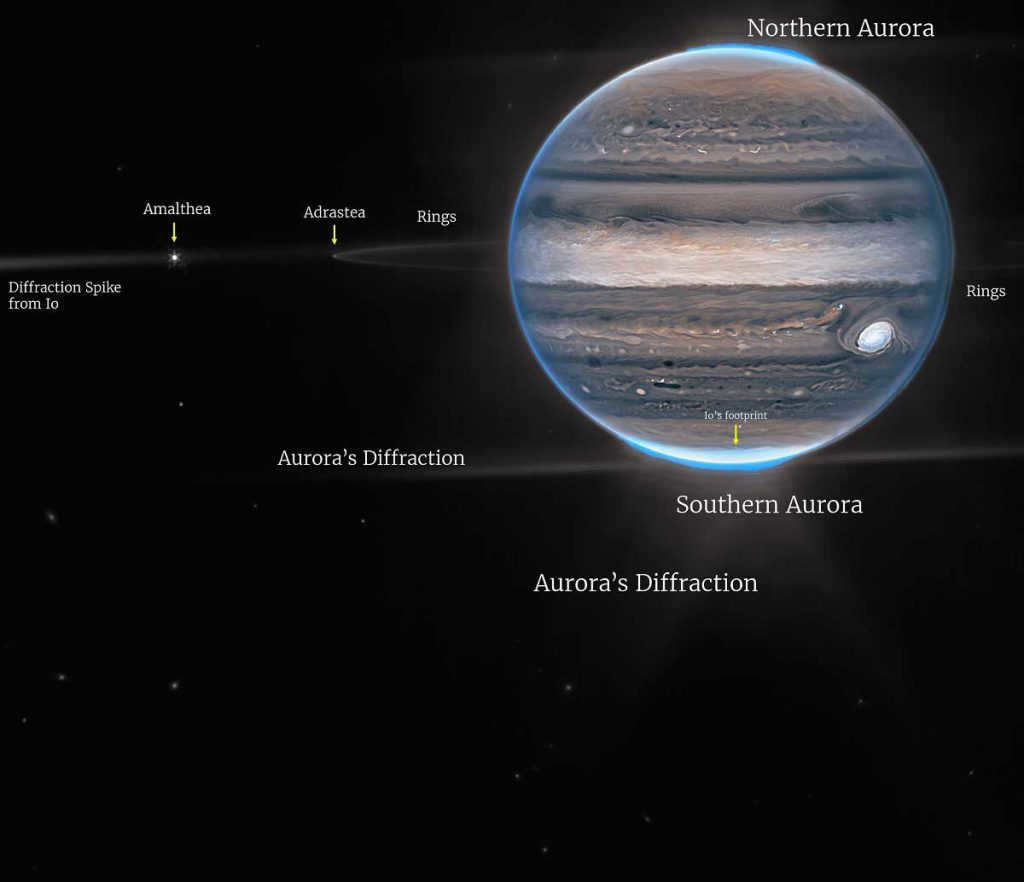
Discovery: The hypothesis of Jupiter having a ring system was first put forward by scientists in the 1960s. Sergei Vsekhsviatsky and his team of Soviet astronomers were the pioneers in proposing this idea. They examined the distant points of comets’ orbits and suggested that these comets could have originated from a ring around Jupiter. According to their theory, the ring might have been formed due to volcanic activity on the gas giant’s satellites.
Several decades later, space probes were sent to Jupiter to validate the Soviet astronomers’ hypothesis. In 1979, during the Voyager 1 flyby of the planet, scientists obtained undeniable evidence of Jupiter’s ring system.
The Jupiterian ring will be captured in a photo taken by the probe’s television camera, with an exposure lasting 11 minutes. Astronomers will be able to observe a prominent light streak crossing the center of the image.
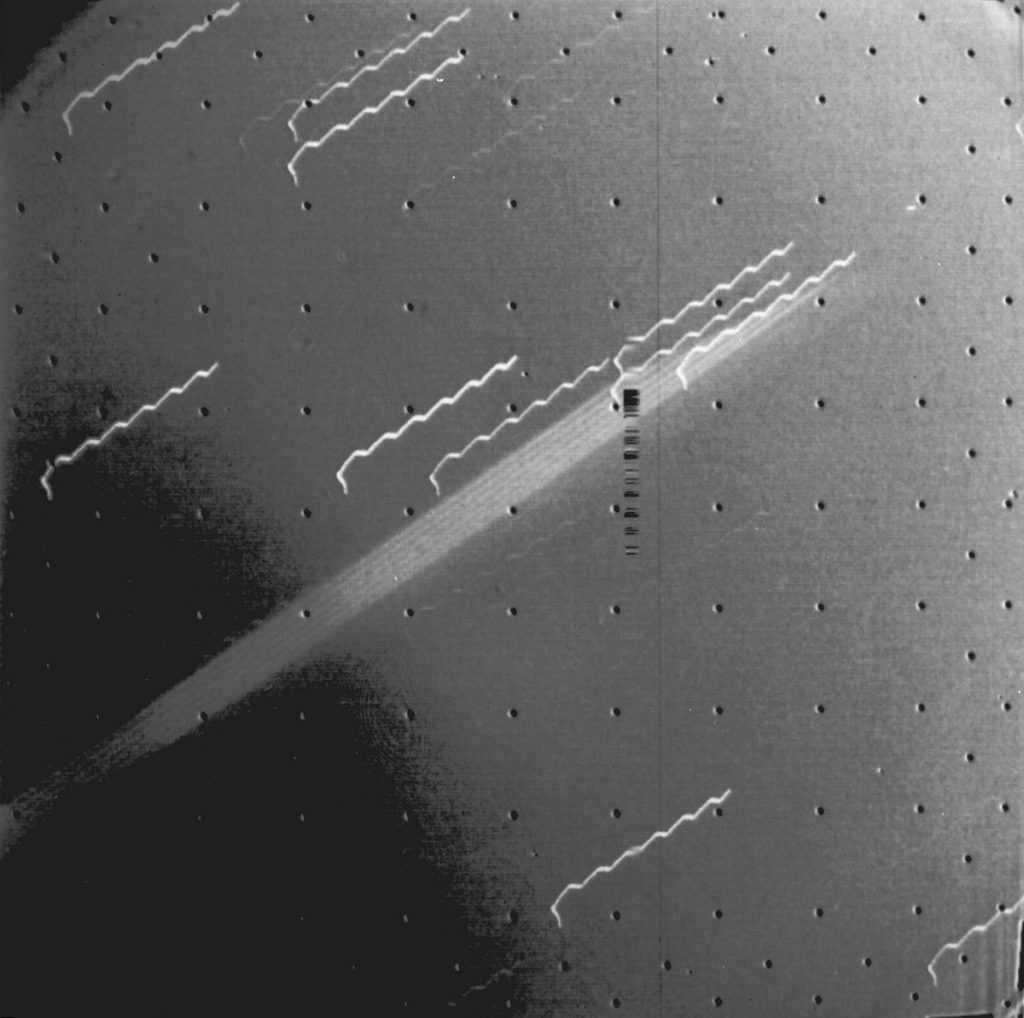
This image provides the initial proof of the presence of rings encircling Jupiter. During the time this photograph was captured, Voyager 1 and the ring were at a distance of 1.2 million kilometers from each other.
Later on, in the 1990s to early 2000s, another spacecraft called Galileo conducted a more comprehensive investigation of the gas giant’s ring system. The probe was able to uncover the origin and characteristics of these rings.
Composition: Jupiter is encompassed by four rings, according to the current knowledge of scientists:
– The innermost ring, known as the halo ring;
– the relatively thin and luminous Main Ring;
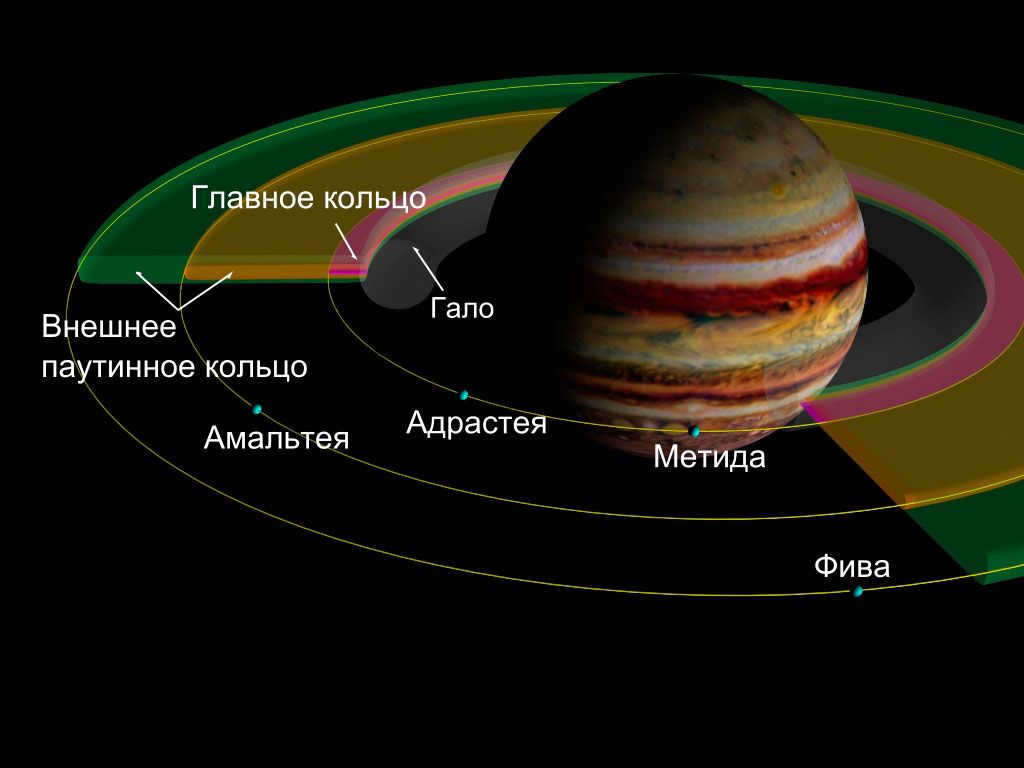
Composition and origin: The composition of Jupiter’s rings consists primarily of ice and small particles of dust that have been ejected from the surface of the four inner moons of the gas giant due to interplanetary meteoroid impacts. The data collected by the spacecraft “Galileo” has revealed that the dust particles are expelled from the rings and the ice evaporates quickly due to the electromagnetic forces of Jupiter’s magnetosphere. On average, the particles in the rings have a lifespan of 500 to 1000 years, indicating a constant need for replenishment. The main sources of material for the rings are the small moons Adrasteia, Metida, Amalthea, and Phoebe. Based on scientific estimates, it is believed that the rings are less than 1 million years old.
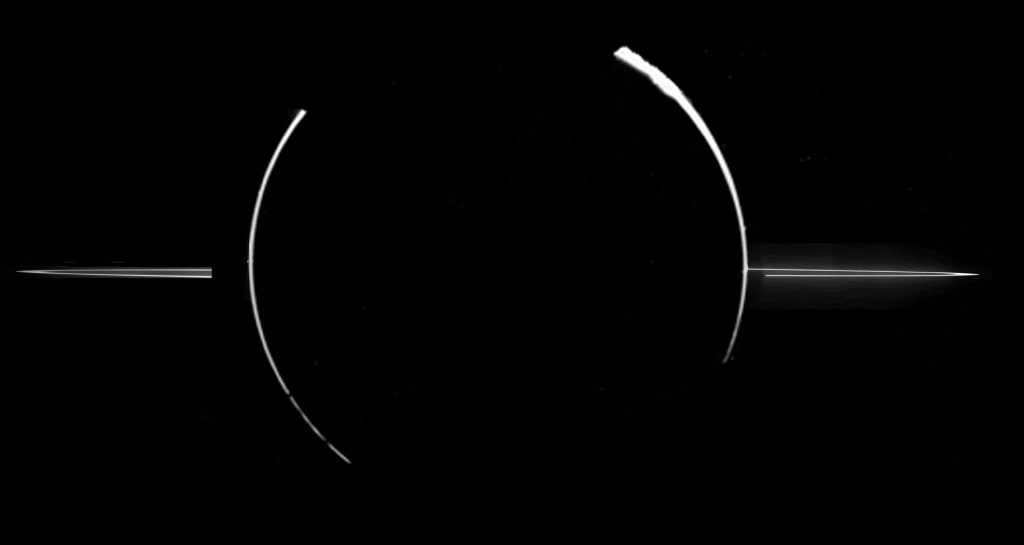

Dimensions: The Main Ring is positioned approximately 125,000 km away from the planet’s center, and it spans 7,000 km in width. This ring is surrounded by the orbits of two smaller Jupiter satellites – Adrastea and Metida. The Main Ring gradually transitions from its inner side to the halo ring, which is a broad and thin torus of material measuring 12,000 to 20,000 kilometers in thickness. The halo ring is situated at a distance of roughly 100,000 km from Jupiter’s center. On the outer side of the Main Ring, there is a wide and extremely faint web ring known as Amalthea.
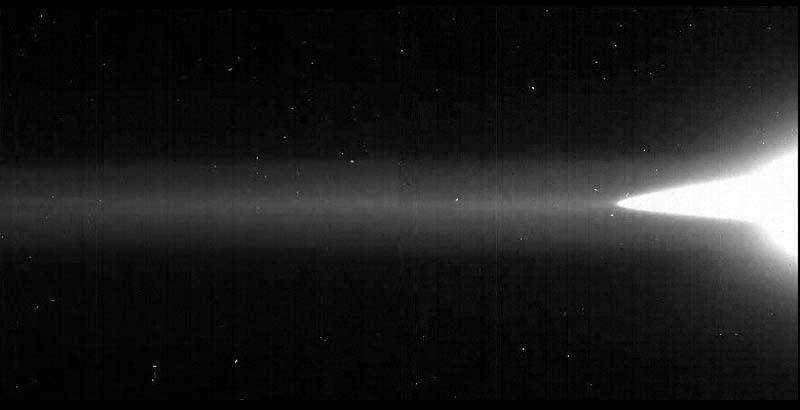
The web ring that surrounds the satellite Amalthea stretches to the orbit of the satellite itself, measuring nearly 2,000 kilometers in thickness and 53,000 kilometers in width. The wider outer web ring, known as Thebes, spans a width of 97,000 kilometers and is primarily located within the orbit of its namesake satellite. The spider ring of Phoebe, on the other hand, is slightly over 8,000 kilometers thick.
Saturn
can be paraphrased as “The planet Saturn”.
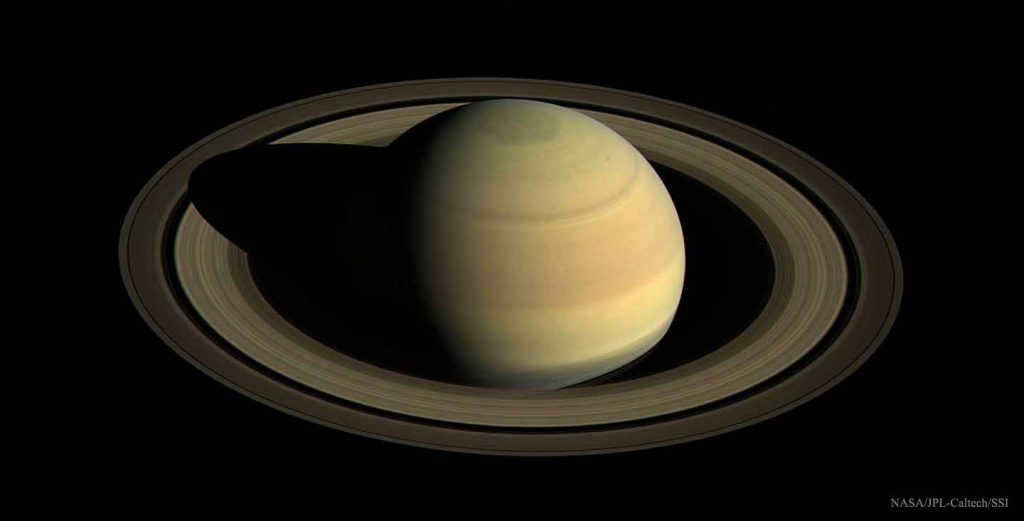
Discovered: The rings of Saturn are visible from Earth and were first observed by Galileo Galilei in 1610 using his telescope with a 20x magnification. However, Galileo was unsure of what he was seeing and described it as “a triple Saturn with two unknown appendages on each side” in his diary. Scientists later determined that these “appendages” were likely satellites or “arms” of Saturn.
It was only 49 years later that the Dutch astronomer Christian Huygens correctly identified the rings surrounding the planet. Using a refractor telescope with a 50x magnification, Huygens was able to see the rings clearly.
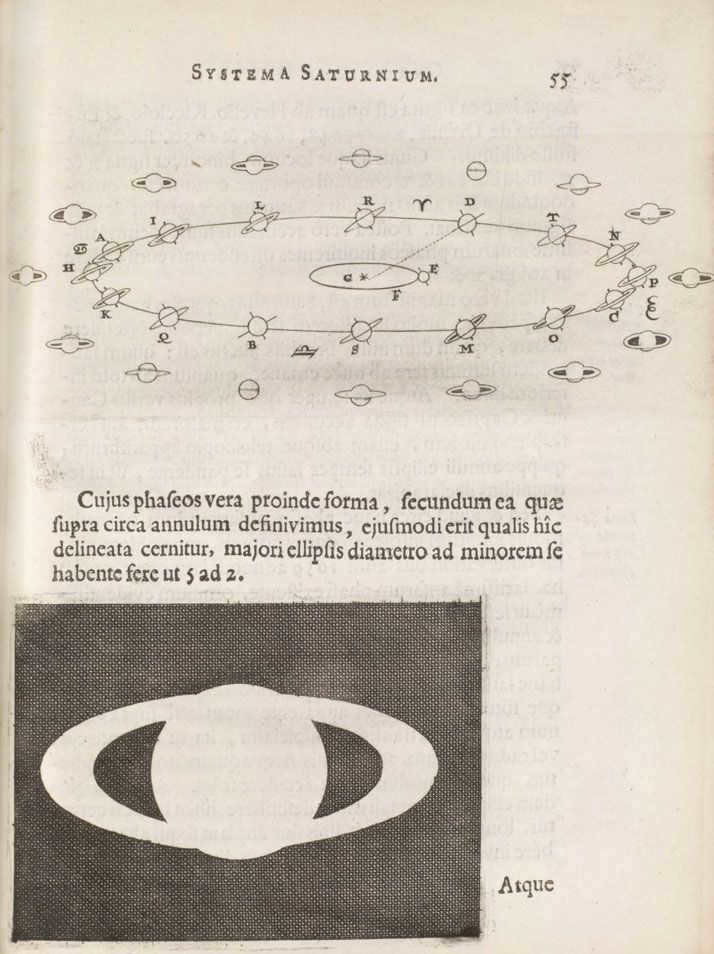
Out of the four spacecrafts that have ever explored Saturn, NASA’s Cassini probe conducted the most comprehensive investigation of the gas giant’s ring system. From 2004 to 2017, the Cassini spacecraft extensively studied both the planet and its rings.
Composition: Saturn is adorned with a total of six primary rings. The initial three rings, namely A, B, and C, are easily observable from Earth, while the remaining rings, D, E, and F, are faint and challenging to detect using ground-based telescopes.
The rings surrounding Saturn are designated by Latin letters based on the order in which they were discovered. The first ring closest to Saturn is known as the D ring, followed by the C ring, the B ring, the A ring, the F ring, the G ring, and finally the E ring. Beyond the E ring, there are even fainter rings, including the largest ring called Phebe’s ring, which is primarily associated with the planet Jupiter. Phebe’s ring is incredibly vast, with a diameter exceeding 10 million kilometers. To truly grasp the enormity of this ring, refer to the accompanying illustration, which provides a schematic representation of Phebe’s ring in relation to the size of the planet itself.
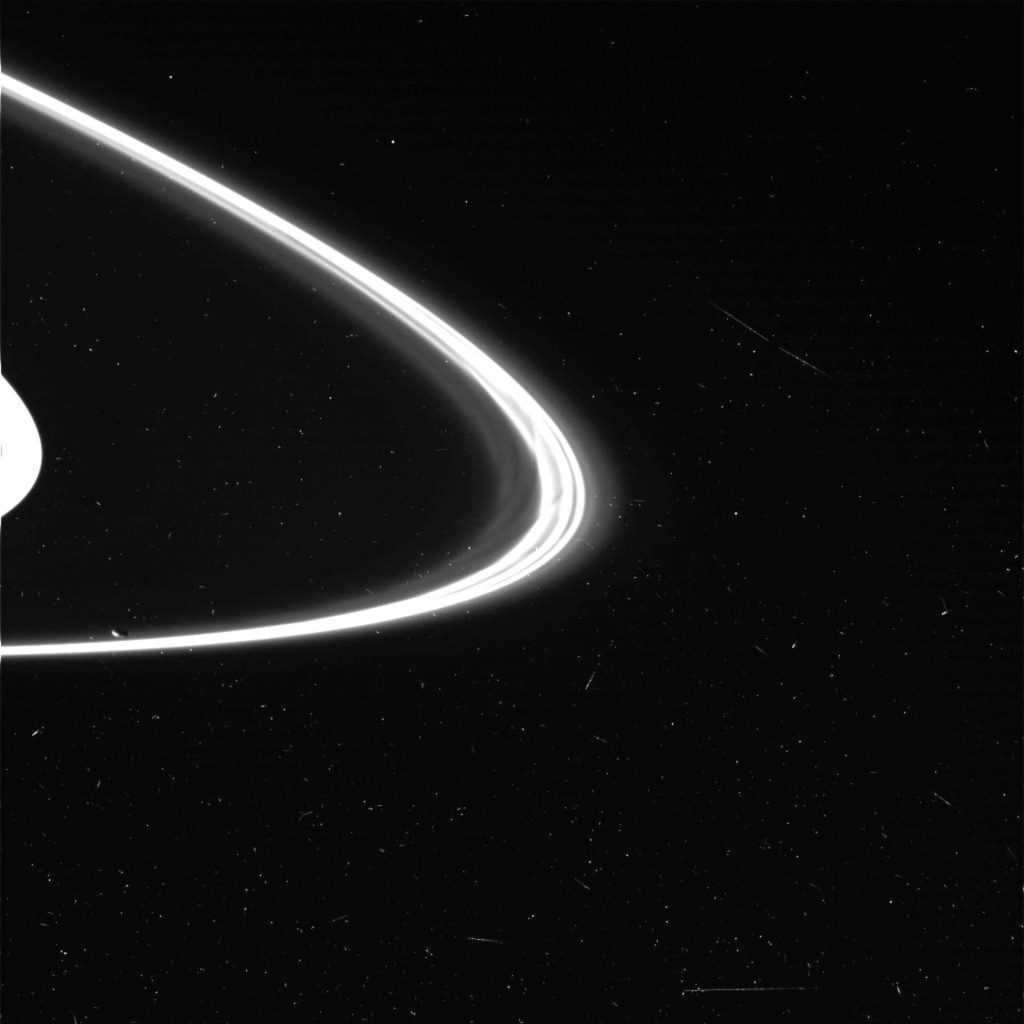

In 2009, scientists made the remarkable discovery of the Theba ring, with the assistance of the Spitzer infrared space telescope.
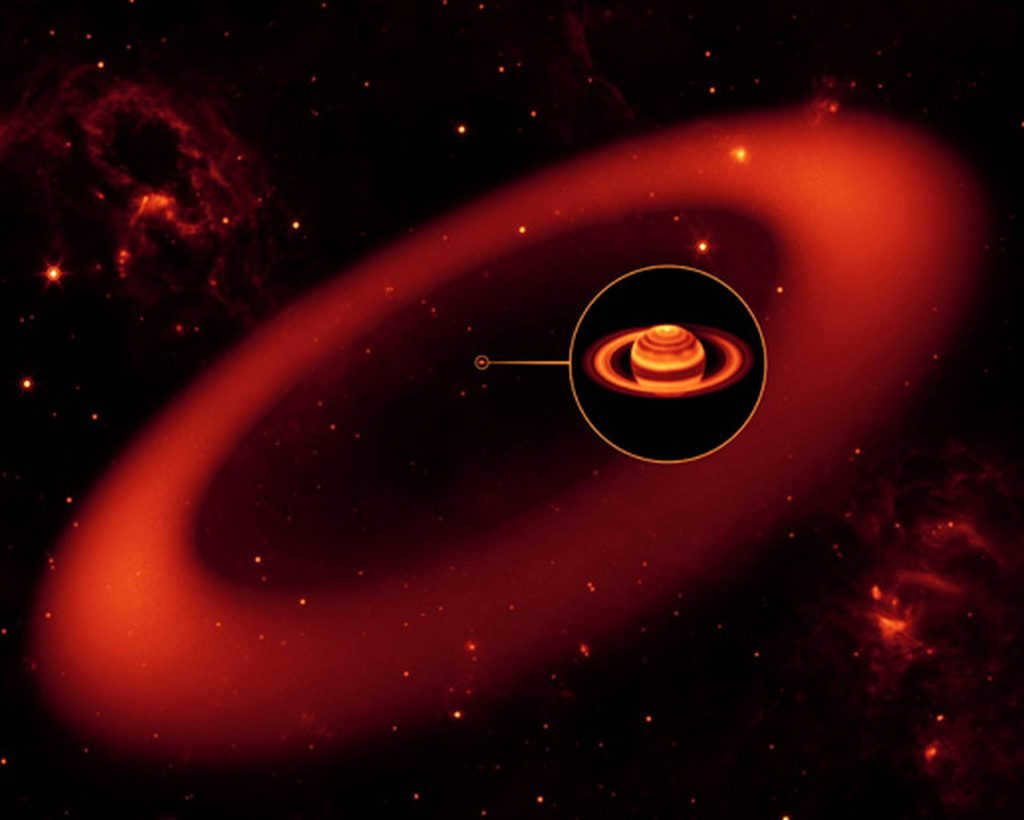

The arrangement of Saturn’s rings is reminiscent of a vinyl record with multiple slender rings, interspersed with gaps devoid of particles. There are numerous such gaps, including the Cassini gap located between rings A and B, and observable from Earth through a telescope.
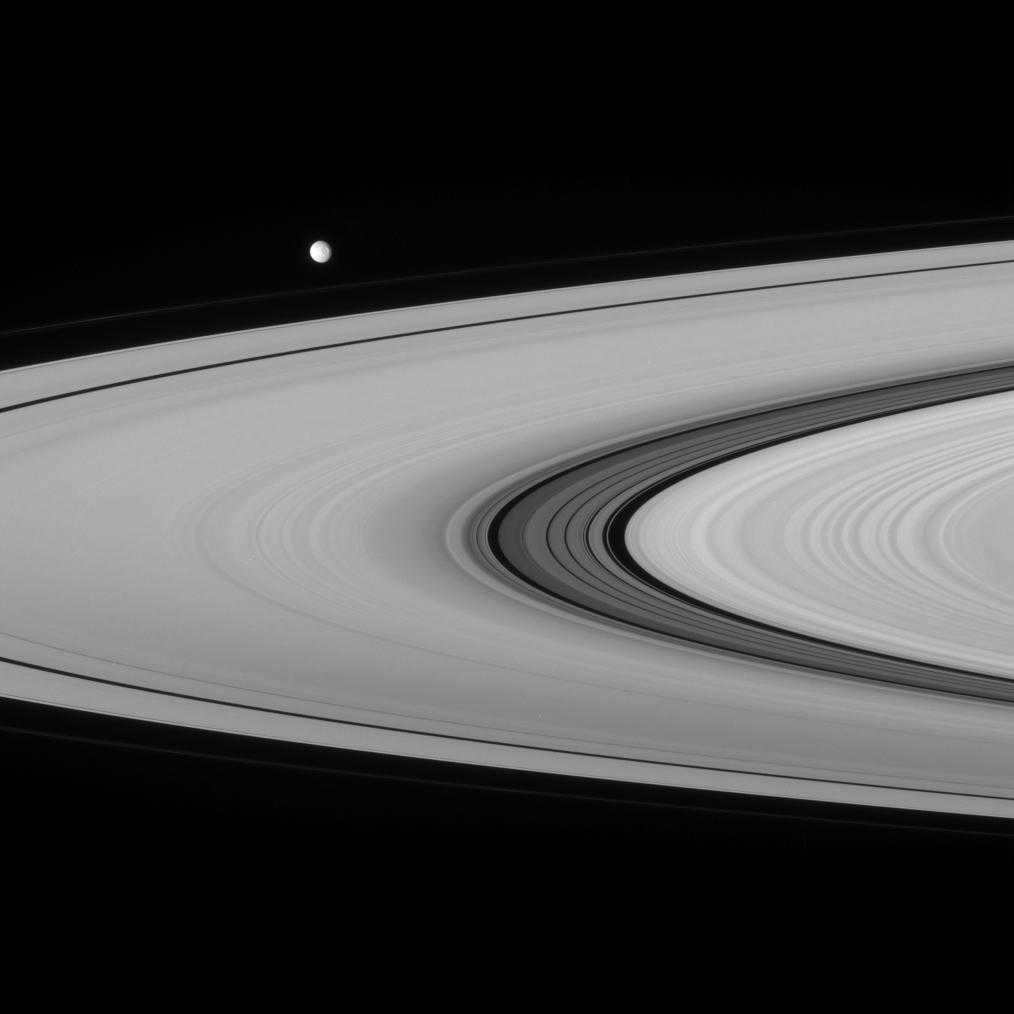
Saturn’s ring system is home to a unique phenomenon known as “shepherd” satellites. These special satellites play a crucial role in shaping and interacting with the rings. Positioned between the rings, their primary purpose is to prevent the outermost sections of the ring from dispersing. Through the force of their gravity, these shepherd satellites have the ability to gather particles or alter their trajectory, resulting in the formation of gaps or changes in the rings’ motion. This fascinating “shepherding” behavior ultimately contributes to the dynamic nature of Saturn’s ring system.
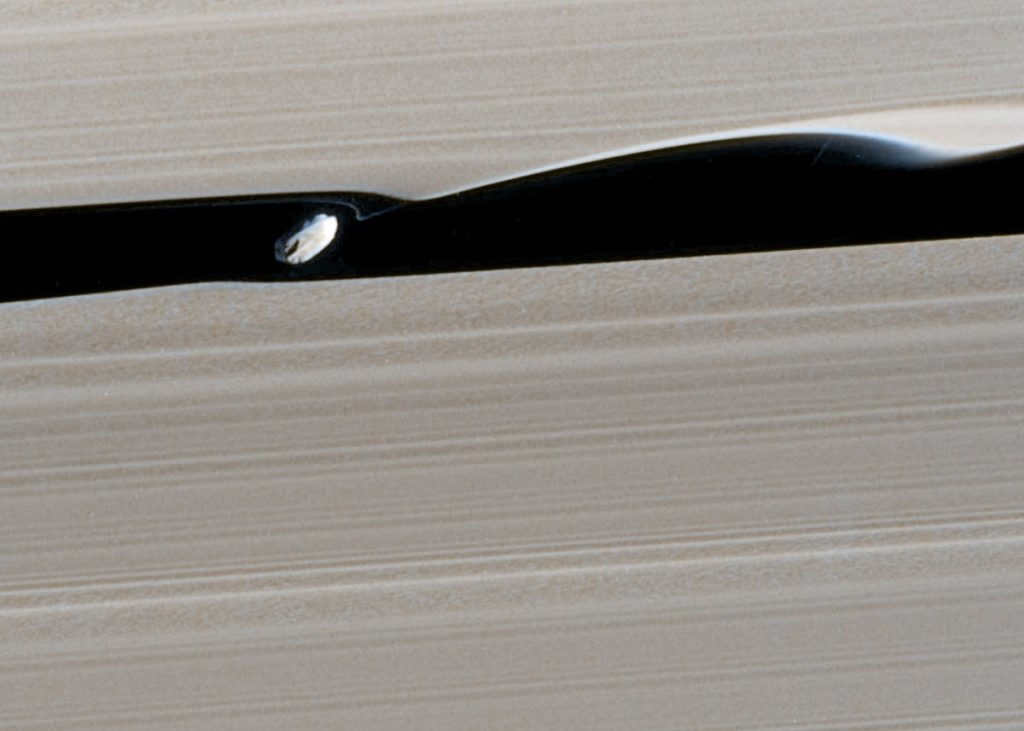
As of 2022, Saturn has 8 known satellites that act as “shepherds”. These satellites include Atlas, Prometheus, Pandora, Daphnis, Janus, Pan, Egeon, and Epimetheus.
For instance, Pan, which has a diameter of only 14 kilometers, is one of Saturn’s smallest inner satellites. It orbits inside the Enke slit of the outer A ring and, due to its gravitational pull, creates swirling bands within the ring. Since the ring particles move at a faster pace in their orbits and are closer to the planet, they experience a “gravitational shock” each time they pass by Pan. This shockwave causes waves to form in the gap, expanding the ring by hundreds of kilometers.
Composition and origin: Saturn’s rings are primarily composed of:
– Debris likely formed from the fragmentation of one or more comets, asteroids, or moons that were torn apart by the gravitational forces of the gas giant.
– Ice fragments ranging in size from tiny flakes to several meter-sized blocks.
These particles all move at nearly the same velocity, approximately 10 km/s, causing neighboring particles to appear stationary relative to one another.
Data from the Cassini mission indicates that the rings are relatively young, estimated to be between 10 and 100 million years old, suggesting they may have formed during the era when dinosaurs roamed the Earth.
Dimensions: The primary rings of Saturn stretch from the planet’s core to a span of 413,000 km. With the inclusion of the Phebe ring, this distance expands to 12 million kilometers. These rings possess a relatively slim profile, with certain sections measuring no more than 10 meters in thickness.
Uranus
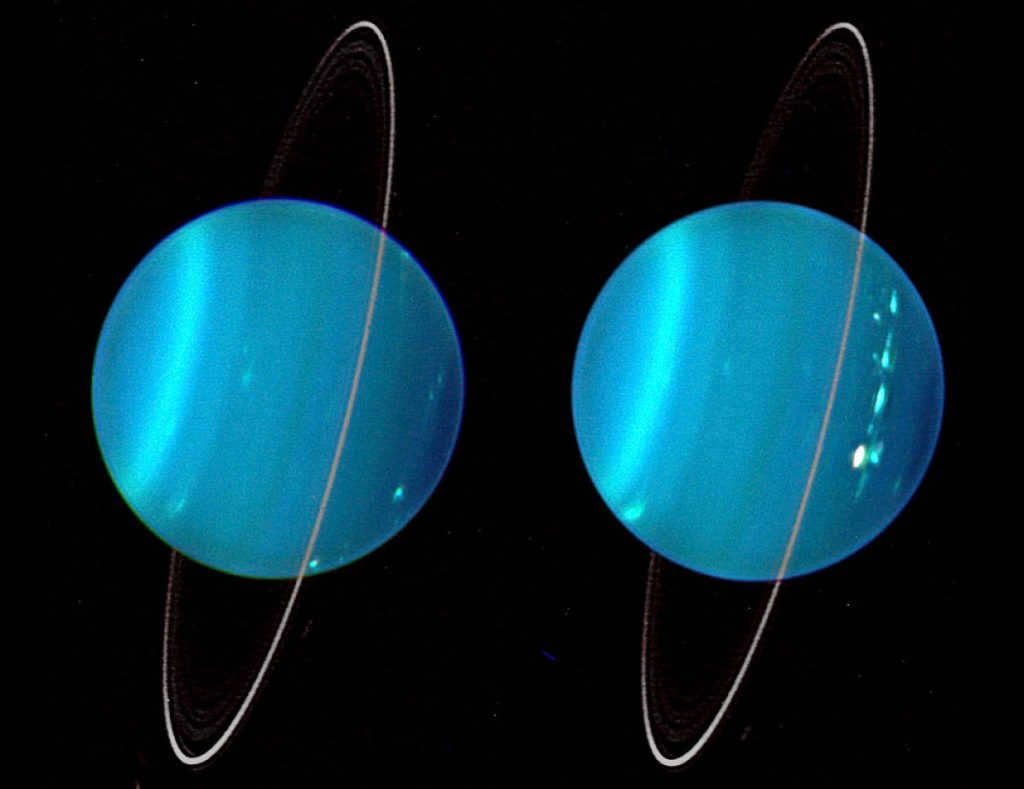
Date of discovery: The rings of Uranus were unintentionally discovered by scientists in 1977 through the use of the Kuiper Airborne Infrared Observatory. Originally, the researchers had planned to observe Uranus’ atmosphere as it passed in front of the star SAO 158687. However, upon analyzing the data, experts noticed a decrease in the star’s brightness even before the planet’s expected passage. Consequently, nine rings of Uranus were revealed.
Shortly afterwards, in 1986, astronomers obtained the initial image of these rings. The Voyager-2 probe captured the photo from a distance of 236,000 kilometers.
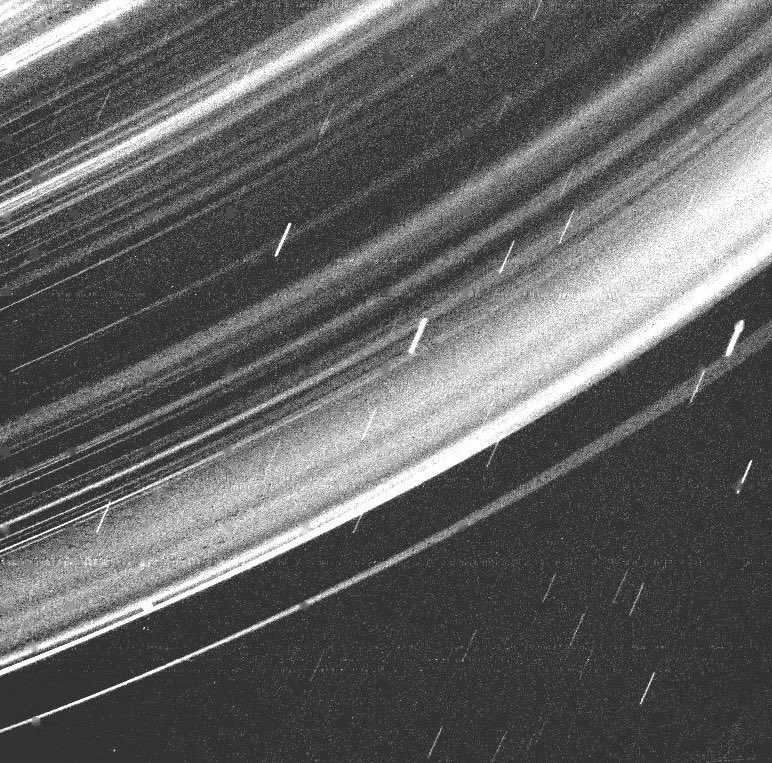
Following this, the rings of Uranus were observed multiple times using both ground-based telescopes on Earth and the Hubble Space Telescope in space. During the period from 1986 to 2005, astronomers made the discovery of four additional rings around Uranus.
Current Status: As of 2022, Uranus is known to have a total of thirteen rings, which have been designated with Greek letters. These rings are named as follows: 1986U2R/ζ, 6, 5, 4, α, β, η, γ, δ, λ, ε, ν, μ.
The initial eleven rings consist of the inner rings: ζ (Zeta), 6, 5, 4, α (alpha), β (beta), η (eta), γ (gamma), δ (delta), λ (lambda), ε (epsilon). These structures are densely packed, narrow, and coal-black in color. The compact, dark, and rocky composition of Uranus’ inner rings stands in stark contrast to the expansive and bright icy rings of Saturn. Not only are these rings a thousand times more Saturnian in nature, but they are also exceptionally dark. In fact, they are so dark that, unlike Saturn’s bright rings, which have been observable through primitive telescopes for over a century, Uranus’ rings could not be detected using ground-based telescopes until the late 20th century.
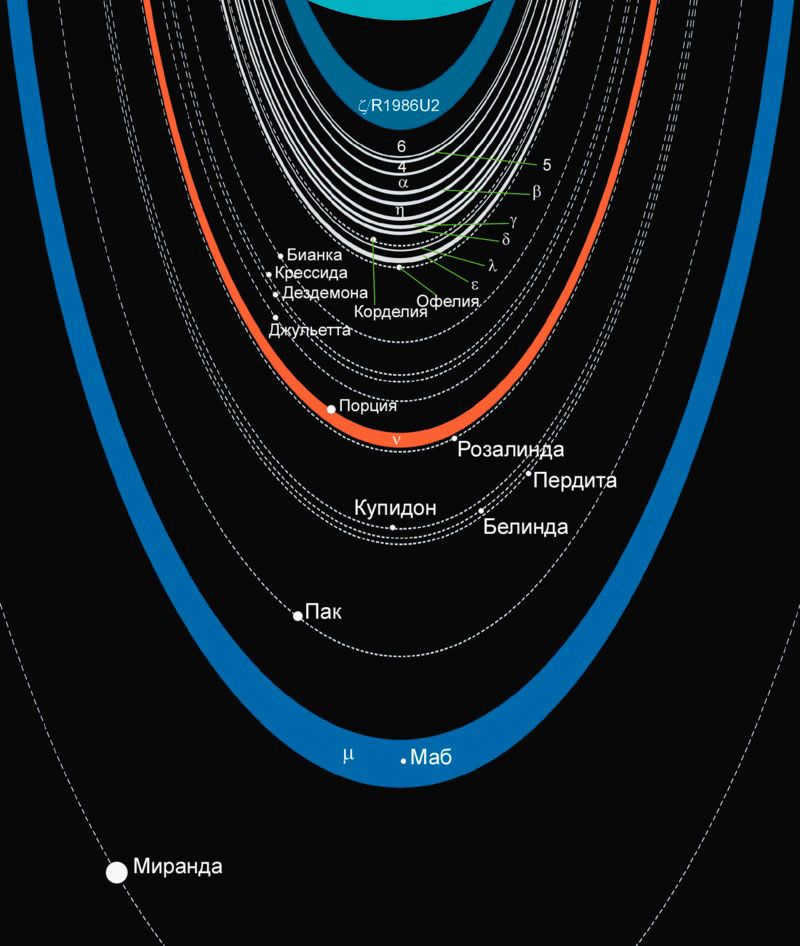
The two additional rings can be classified as the outer rings: ν (Nu) and μ (Mu). They possess distinct characteristics compared to the thin inner rings, being wider and less visible, with widths ranging from 3800 km to 17000 km.
The satellites known as “shepherds”: As of 2022, Uranus is accompanied by a total of 27 satellites, all of which are named after characters from the literary works of William Shakespeare and Alexander Pope. Among these satellites, Uranus harbors 13 inner satellites that orbit within the trajectory of its closest moon, Miranda.
All the inner moons have a close connection with the rings of the planet. For instance, the two nearest inner moons, Cordelia and Ophelia, act as the “guardians” of the ε ring, while the moons Mab and Puck likely contribute material to the farthest μ ring.
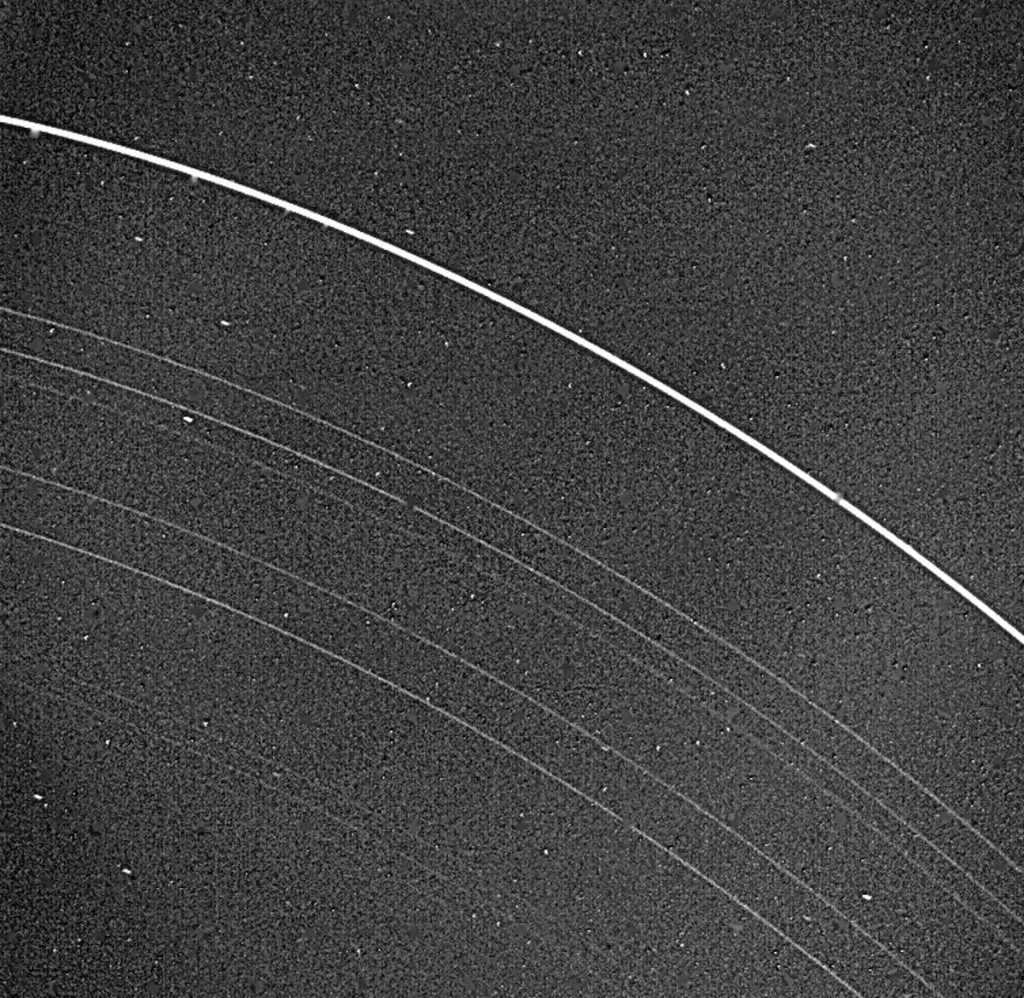
All of Uranus’ inner moons are dark celestial bodies. These satellites consist mainly of frozen water with traces of dark matter. The smaller inner moons constantly affect each other’s orbits and, as a result, they can cross paths and collide.
Composition and Origins: The rings encircling Uranus are primarily made up of tiny particles of dust, frozen water, and possibly carbon. The narrower rings surrounding the planet may consist of particles varying in size from centimeters to meters.
Dimensions: The rings of Neptune vary in size, ranging from 1 km wide (λ ring) to 17,000 km wide (μ ring). These rings are located at a distance of 32,000 km to 100,000 km from the planet.
Neptune
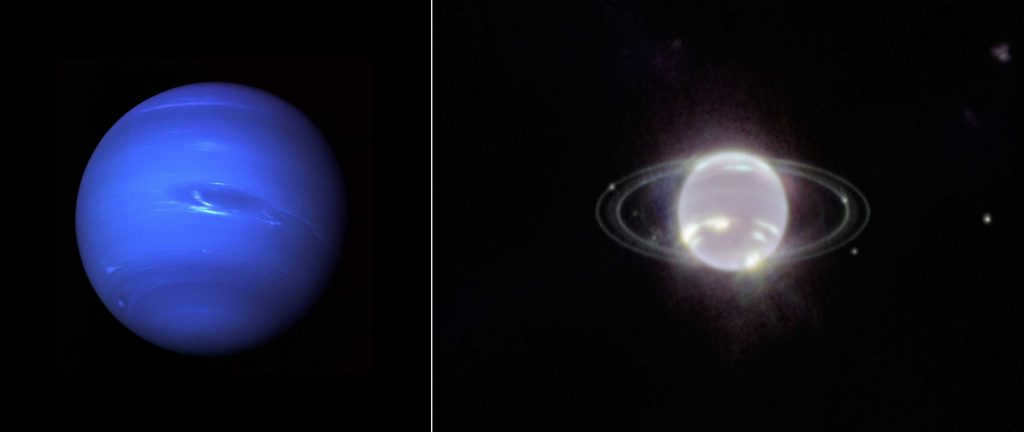

Discovery: The concept of Neptune having rings has been proposed by scientists since the mid-20th century. In 1984, French astronomer André Braic made observations of the planet and discovered that when the ice giant passed in front of a distant star, its light was periodically blocked three times by objects located at the same distance from Neptune. These objects were known as arcs and were believed to be segments of an incomplete ring.
After a span of five years, astronomers were finally able to confirm the presence of a ring system around Neptune. The year 1989 saw the Voyager 2 probe capturing a stunning image of these ring formations.
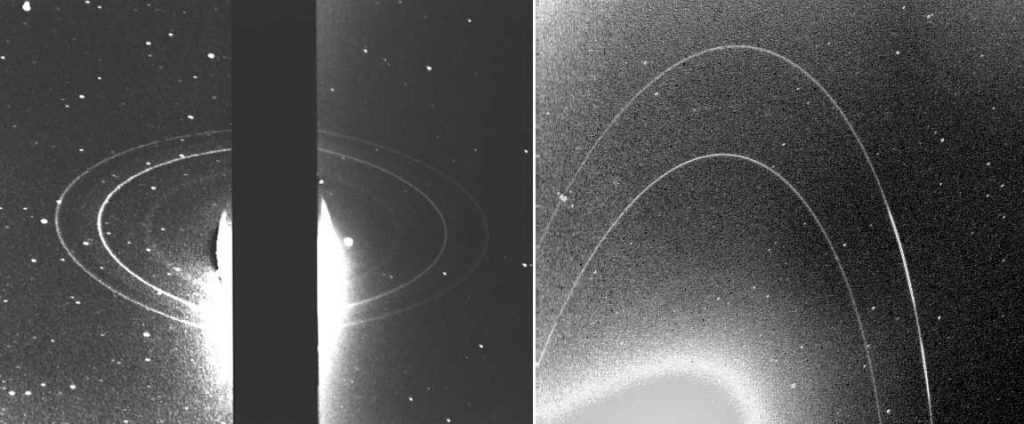

It has been discovered that the rings of Neptune are exceptionally dark, reflecting less than 3% of the light that hits them. However, when observed from the unlit side, the rings appear much brighter.
Composition: Neptune is encircled by five primary rings. The closest to the planet is the Halle ring, followed by the Leverrier, Lascelles, Arago, and Adams rings.
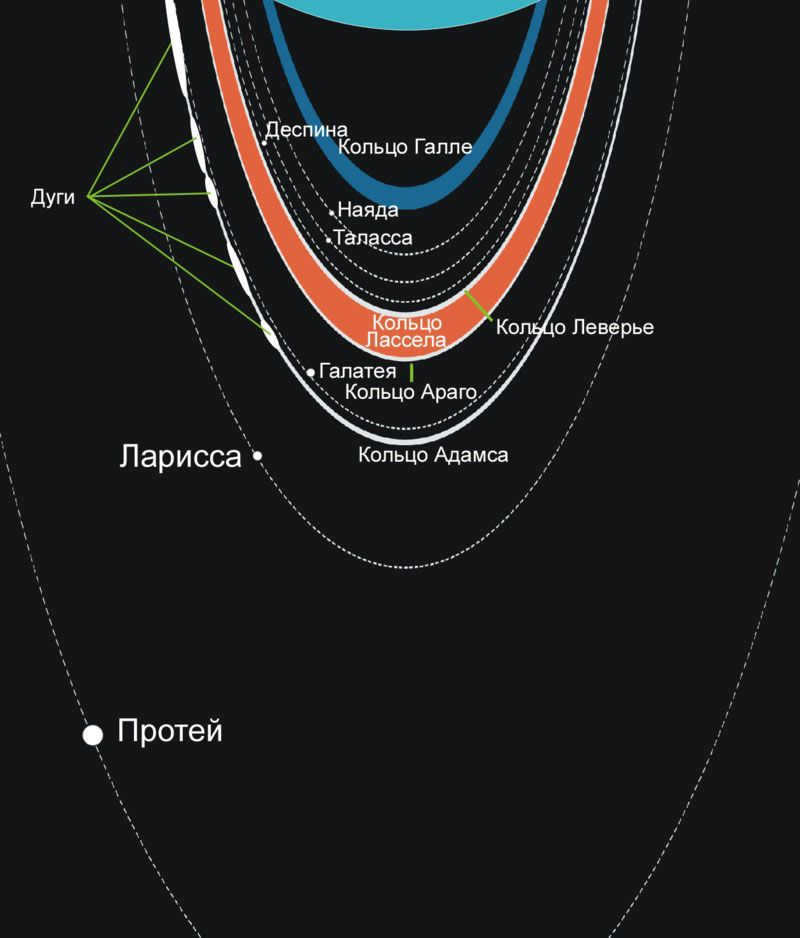
Previously, it was believed that the positional stability of the arcs was due to the gravitational impact of Neptune’s companion, Galatea. Galatea occupies an orbit within the inner edge of the Adams ring. However, recent studies have disproven the notion that Galatea’s gravitational force alone is responsible for maintaining the arcs in their current location. Therefore, it is inferred that an additional satellite exists. Scientists hypothesize that this satellite is relatively minuscule, with a diameter of no more than 6 kilometers. The satellite’s small size explains why it has eluded detection thus far.
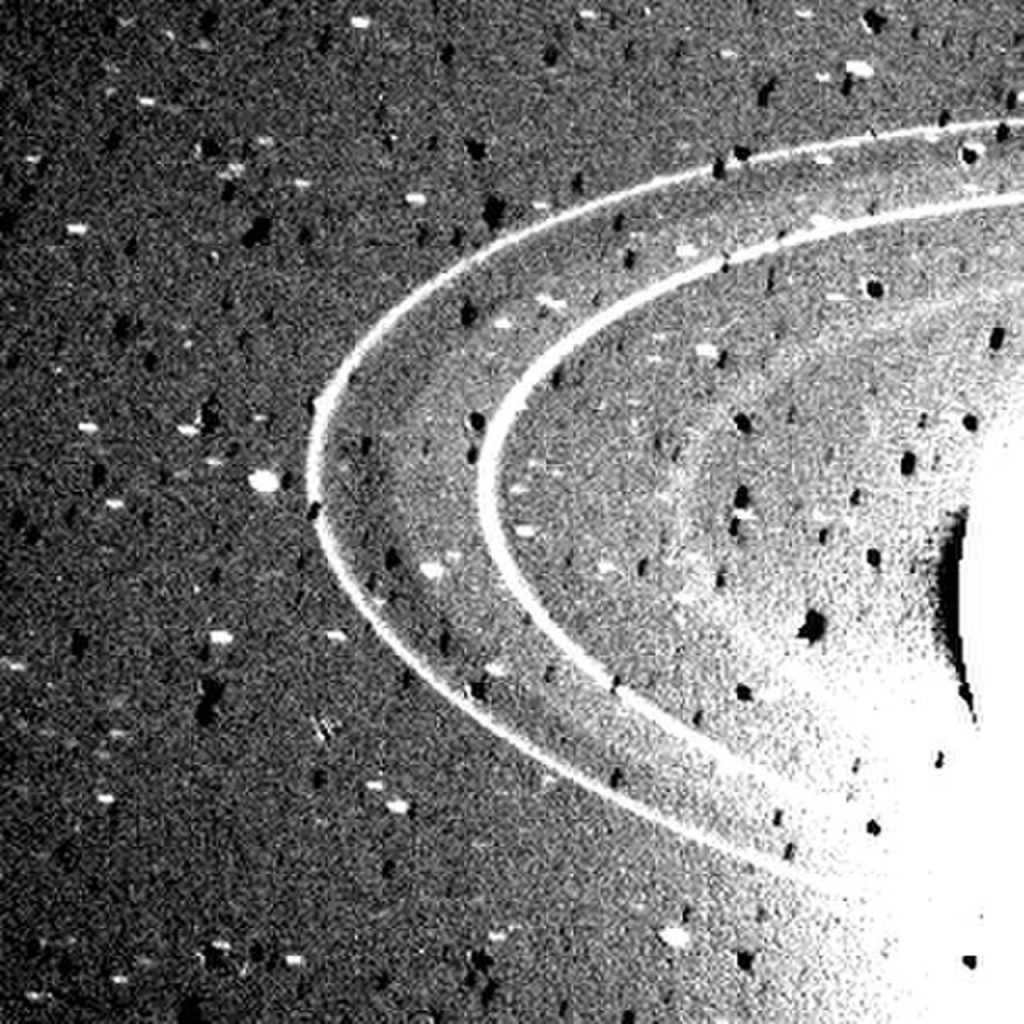

Shepherd moons: Like other gas giants, Neptune has a group of inner moons that interact with its rings. A total of seven moons make up this group: Naiad, Thalassa, Despina, Galatea (which is part of the Adams ring), Larissa, Hippocampus, and Proteus.
The moons Despina, Naiad, and Thalassa orbit between and affect the Halle and Leverier rings. On the other hand, Larissa, Hippocampus, and Proteus orbit on the outer edges of the ring system.
Composition and origin: The ring system of Neptune likely formed in conjunction with the planet billions of years ago, originating from the remnants of a nearby cloud of matter. These rings are made up of extremely fine particles that are dark and dusty, with a coating of either silicates or carbon-based material. It is the carbon-based material that most likely gives the rings and arcs their reddish hue.
Size: The first ring, known as Halle’s ring, is wide and is situated 41,900 km away from the center of Neptune. Following Halle’s ring is the narrower Leverier ring, which is located 53,000 km from Neptune. Next is the wide Lassella ring, positioned at a distance of 55,400 km from the planet. After Lassella comes the Arago ring, located 57,200 km from Neptune, and finally, the narrow Adams ring, which is situated 62,000 km away from the planet.
The Lascelles ring holds the title for being the widest among Neptune’s ring system, measuring a staggering 4,000 km in width. On the other end of the spectrum, we have the Adams ring, which boasts a more modest width that doesn’t exceed 50 km.
Rings on Satellites and Asteroids in the Solar System
It’s important to note that planets aren’t the only celestial bodies in the solar system that possess rings. In fact, ring systems can also be found around satellites, asteroids, and even dwarf planets.
In 2013, a groundbreaking discovery was made when scientists detected two rings encircling the asteroid known as Chariklo. These rings, while relatively narrow, make up for it in density and intrigue. The first ring measures 7 km in width and is located approximately 391 km away from the asteroid’s center. The second ring, found at a distance of 405 km, has a slightly smaller width of 3 km. These two structures are separated by a gap that spans 9 km.
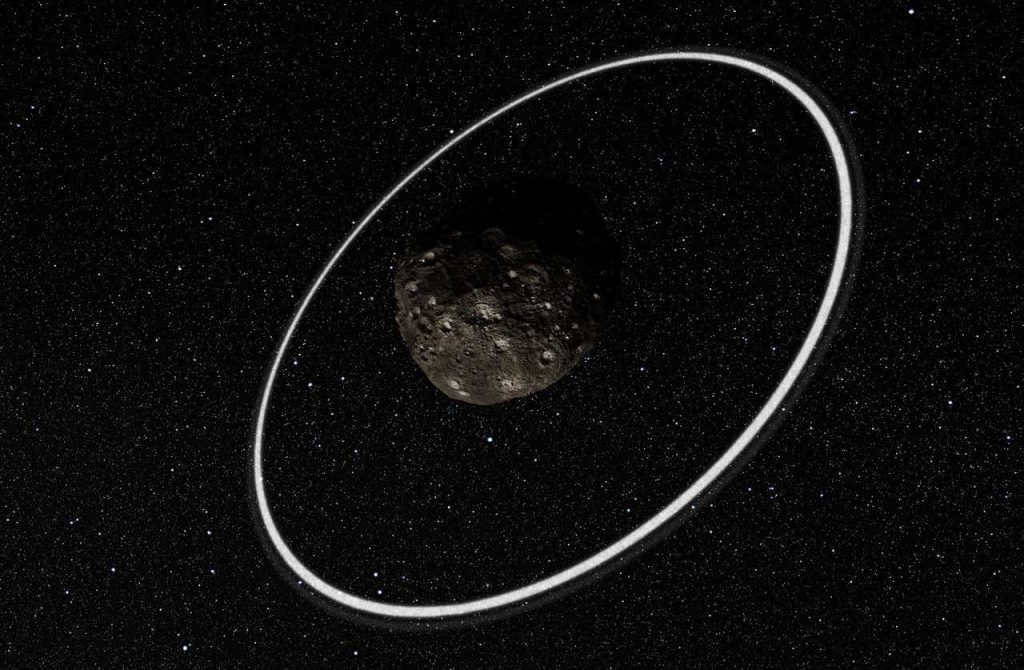

Chariklo, the largest member of the Centaur group, is an asteroid that orbits between Jupiter and Neptune. It measures 250 kilometers in diameter.
In 2015, a team of Spanish astronomers put forth a theory suggesting that Chiron, another centaur, also possesses rings. This hypothesis is based on irregularities in the asteroid’s brightness, which occur when Chiron passes in front of stars. Experts believe that these irregularities may be caused by rings located approximately 324 km from the centaur’s center.
In 2017, researchers made a remarkable discovery when they detected a ring encircling the small celestial body known as Haumea. Situated in the Kuiper belt, which lies beyond the orbit of Neptune, Haumea’s ring boasts a width of approximately 70 km and spans a radius of 2000 km to 2500 km.
Within our solar system, the presence of rings is not an uncommon occurrence, as they can be found adorning various cosmic entities.
For instance, experts propose that the icy formations surrounding Saturn’s moons, namely Iapetus and Rhea, were once in the form of rings. However, due to reasons that remain elusive to scientific understanding, these rings eventually collapsed onto the surface. It is believed that the ring that precipitated onto Iapetus’ surface is responsible for the formation of its prominent mountain range.
It is plausible that in the coming million years, Mars might also develop dust rings, potentially triggered by the impact of its moon Phobos on the Martian terrain.
Rings around exoplanets
There is a growing belief among scientists that numerous exoplanets could possess rings similar to the ones found in our own solar system.
Up until now, only one exoplanet – Super Saturn 1SWASP J1407 b – has been discovered with such rings. This particular exoplanet is a gas giant that some argue may actually be a brown dwarf. It weighs approximately 26 times the mass of Jupiter* and orbits the massive star J1407, located 434 light-years away from our planet Earth.
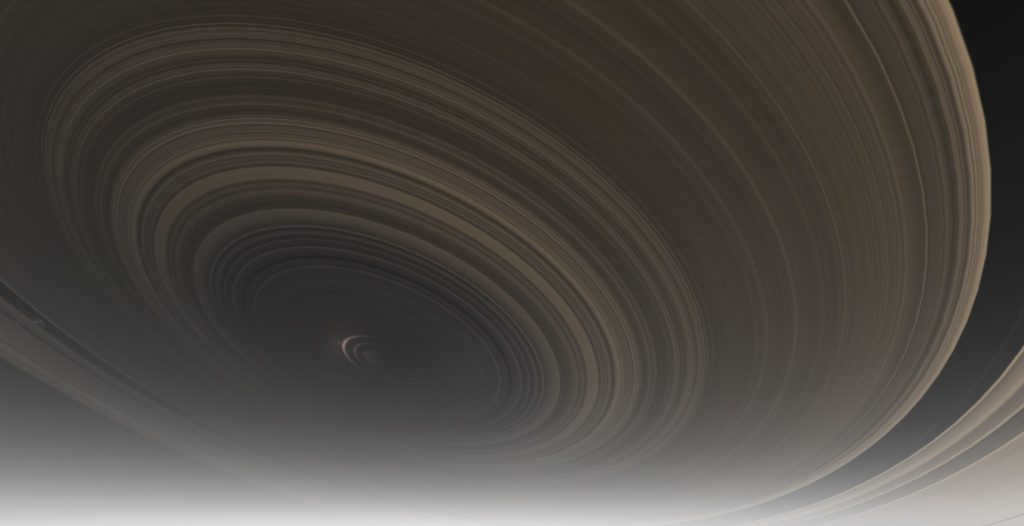
Scientists have discovered that 1SWASP J1407 b has an astonishing 30 rings, each with a radius of tens of millions of kilometers. This is in stark contrast to the largest ring of Saturn, which has a radius of only about 480,000 kilometers. If Saturn had rings as large as those found on 1SWASP J1407 b, we would be able to observe them in our night sky as close as the Moon.
So why have scientists only found rings on one exoplanet so far? It is possible that most exoplanets have rings that are too dim to be easily detected, but the rings on 1SWASP J1407 b are much brighter. Experts are constantly improving their methods for detecting these rings, and it is likely that we will soon learn about other exoplanets with similar ring structures.
*The mass of exoplanets is measured using Jupiter as a reference because it is the largest planet in our solar system






